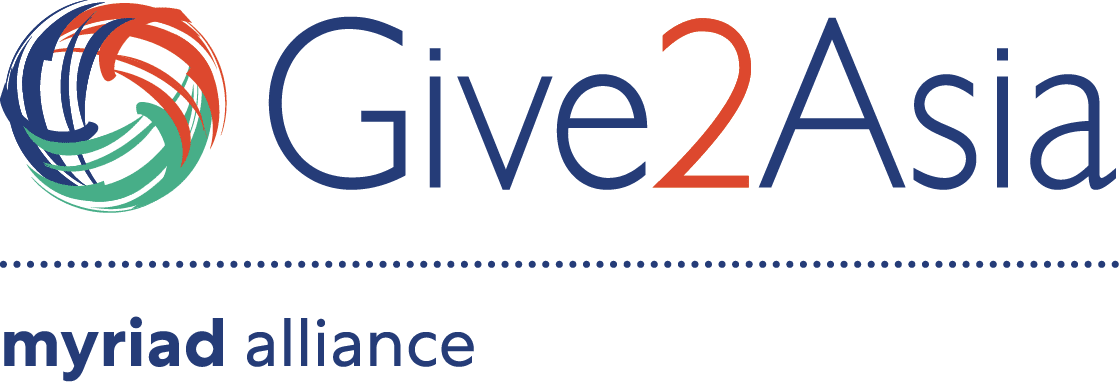Dr. Rahmat discusses Project HOPE's COVID-19 relief activities and current grantmaking priorities in Indonesia
Give2Asia President & CEO Birger Stamperdahl had an opportunity to interview Dr. Edhie Rahmat, Executive Director of Project HOPE Indonesia, at the 2021 Innovations in International Philanthropy Symposium. Watch the full interview or read the transcript below:
To learn more about Project HOPE’s COVID-19 prevention work in Indonesia, see our recent case study on Localized COVID-19 Training to Protect Indonesian Healthcare Workers.
Interview Transcript
Birger Stamperdahl (Give2Asia): Greeting everyone, welcome to pre-recorded interview for the Southeast Asia Regional session. I am Birger Stamperdahl, the president of Give2Asia, a public charity in San Francisco that supports advised grant-making to local organizations across Asia. And I am grateful today to be sitting here virtually with Dr. Edhie Rahmat, the Executive Director of Yayasan Project HOPE in Indonesia. He’s based in Jakarta. In an article during the first week of August, CNN describes Indonesia as now being at the epicenter of the world’s COVID pandemic. It is the world’s fourth most populated country and just in the past month 1.2 million new COVID cases have been reported in Indonesia.
Dr. Rahmat is a medical doctor and an epidemiologist, he has extensive experience in health sector programming and managing humanitarian assistance to natural and man-made disasters. Dr. Rahmat has worked on behalf of major development partners like the World Bank, The European Union, USAID, The International Committee of the Red Cross and others. He is now the Executive Director of the Yayasan Project HOPE in Indonesia, which is a not-for-profit foundation that is the extension of the international Project Hope NGO.
I’ll also note that Yayasan Project HOPE is a grant recipient of Give2Asia and most recently has received support of COVID-19 programming in the past 14-16 months. So thank you Dr Rahmat for joining us, and for joining me for this interview. So to give some people background on Project HOPE, could you please share a little bit about the organization’s mission?
Dr. Edhie Rahmat (Project HOPE Indonesia): We envision a world where everyone has access to the health that they need to reach the full potential of their life through a strong and resilient global community of health care workers. Our mission is to put the power at the hands of local health workers to save life across the globe.
Birger: I was planning on asking you some questions about the work of your organization specifically as sort of a case study of what’s happening in Indonesia and then asking you some broader question about how you see the non-profit sector generally in Indonesia that might extend to the situation in other countries. So I guess to look specifically at Project HOPE, first of all, where does Project HOPE get its funding and how much of its funding right now is overseas funding?
Dr. Rahmat: Yeah, we are actually raising funds locally in Indonesia, in particular during emergency response, like assistance for victims of earthquake and tsunami in central Sulawesi region. But 80% of our funding for health sector programming for development actually comes from overseas donors.
Birger: Thank you. So, when the pandemic started, first of all how did it affect your team, how is your staff and the organization affected directly by the pandemic?
Dr. Rahmat: You know that everybody was not prepared for a pandemic, including us. Some of our field officers that working in government buildings contracted the virus, where also other healthcare workers were infected by the virus when they share room with them. They have to be in self-quarantine, working from home, and the government travel restriction also limited us to our beneficiary. We have to change our modality from direct to direct meeting to virtual meeting, conducting training etc. But we have to maintain quality and expected impact to the target audience. So we understand that human for care are even increasing during pandemic but we have to apply new ways of working according to government health protocol.
Birger: So how did you decide what project or how to prioritize the need during the pandemic, you know, to sort of match your organization’s skills or access to have an impact.
Dr. Rahmat: Actually we were struck by the number & percentage of healthcare workers that contracted by the virus, some of them died by the virus for example. Up to now more than 1,500 help care worker died because of the virus. We also learnt that pregnant women and children also infected and we suspect that the COVID-19 transmission may happen within the health facility, meaning that we have to protect help care workers, but also we have to protect mothers, children from getting infected by the virus.
So we change our approach that we need to identify the needs at health facilities and we understand that most of health facilities have insufficient personal protective equipment. And our baseline assessment showed that healthcare worker knowledge and practice on correct use of personal protective equipment is very low, the practice on donning, doffing, PPE as low at 55 percent and they had hygiene practice also less than 60% score. With this we also need to help local governments to protect both healthcare workers and the clients.
Birger: You mention one of the projects that we were involved with, which was called Train-the-Trainers. That was a project that helped to train healthcare professionals to keep themselves and the community protected during the pandemic. Dr. Rahmat, could you talk a little bit about the impact of the project and how many healthcare workers you reached, etc?
Dr. Rahmat: We applied a “cascade approach” for delivering messages to our target beneficiary. At the national level, we trained about 115 master trainers on infection prevention control program and through a combination of on-site and virtual training, through doctor-to-doctor online webinar we can expand to reach about 39,000 of health workers with basic knowledge on infection prevention control. We can reach more health care workers through the train-the-trainers projects.
Birger: Can you maybe give us a sense of what the cost of the project was to deliver and how many dollars it cost for each healthcare worker that you were training? Just to give us a sense of the kind of impact donors can have with projects like that in southeast Asia.
Dr. Rahmat: We implemented $150,000 USD grant for saving health care workers, and we can reach 39,000 health care workers with basic infection prevention control knowledge, meaning that for $4.5 USD we can help one healthcare worker receiving basic infection prevention control knowledge. And from other projects we also learn from [the] Saving Life grant that if we invest $3 USD, we could make a pregnant woman screened and tested for COVID-19.
Birger: Well, we know that US dollars can go a long way and have a big impact in Southeast Asia for projects like this. And it gets us talking about your perspective more on the non-profit structure in general in southeast Asia and in Indonesia. So for donors who are interested in making maybe the biggest impact they could make in Indonesia right now, here do you suggest you know they start looking or what are the biggest funding needs just generally in Indonesia that you see right now?
Dr. Rahmat: We learnt that from statistics that the COVID-19 second wave is [now] declining, the number of people getting infected and died because of the COVID-19, but the second wave is not over. We learnt that the outbreak is actually moving from the urban to very rural locations, to very rural districts to outside Java island. And we can understand that the provision of oxygen concentrators, for example, could make a difference to make hospitals at poor districts to be self sufficient to provide oxygen when demanded by the patient that need oxygen supplies. In addition to that, we learned that more and more pregnant women and newborns are contracting and infected by the virus and even died because of the virus. And some of them have no access to emergency rooms at hospitals when the hospitals are overwhelmed with COVID-19 patients. So I think provision of COVID-19 screening to pregnant women, supplying them with personal protective equipment, or helping the health facility to be more ready when mothers or babies are in need of emergency care is also necessary.
Birger: So for a donor who’s evaluating different nonprofits and the work that they do in Indonesia—we know that there’s a fairly healthy non profit sector in Indonesia as there is in quite number of southeast Asian countries—do you have any advice on how they should evaluate or what they should look for when they are considering a nonprofit to work with?
Dr. Rahmat: Yes, from the quantity perspective, donors need to monitor how many workers, how many pregnant women, how many facilities are reached and supported by the invested grant. But we also need to monitor the quality of the program, what is the quality of the outcome. For example, we need to measure the improved practice on handwashing after the health worker received infection prevention control training. Also, when we donate oxygen concentrator machines, we need to also rate how many people are served and utilize the donated machine, and how many lives can be saved by donating oxygen concentrators in a hospital. This is not an easy measurement, but we need to monitor this. And the third thing, we need to measure the sustainability of the activity. In our program, for example, we try hard to insert our program into the system since the launch of the program. We need to build the connection of the infection prevention control program within the existing hospital accreditation system so they can sustain after the project finishes.
Birger: Great, thank you Dr. Rahmat, I think maybe one last question here which maybe ends on a fundraising note for you. What initiatives are Project HOPE currently raising funds for and what are the additional sort of projects that you have plan for the rest of this year?
Dr. Rahmat: At the moment we are raising donations for oxygen concentrators, we plan to distribute 200 hospitals in very rural areas that are hard hit by the pandemic, to build the resiliency when they have to treat patients with COVID-19 and need oxygen supply. In addition, we would like to expand our reach of the Saving Lives of Healthcare Workers [program]. We want to expand our infection prevention control program to additional hundreds of hospitals in rural districts with the potential for distributing also personal protective equipment. And we would like also to continue to insert mental health programs inside the hospital team so that the mental health program could sustain within the supported hospital. And we’re struck by increasing number of maternal and neonatal deaths directly or indirectly impacted by the COVID-19. We need to combine the infection prevention control program within our existing saving life activity. That’s our current plan.
Birger: Well thank you dr. Rahmat for the discussion today. I think it’s really helpful for donors to just hear the perspective and activities of people and groups that are doing the work in the country and in southeast Asia right now that’s been so impacted by the pandemic. So I greatly appreciate you taking this time to step away from your work and speak with me. Best of luck to you and the Yayasan Project Hope.
Dr. Rahmat: Thank you very much for giving the opportunity to talk with you, to be interviewed, and to raise awareness to our current situation in southeast Asia and particularly the Indonesia situation. Thank you very much.



